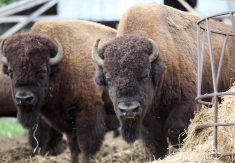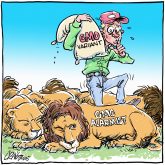Many factors cause deer population boom
Brian Cross’s article, “Deer population called out of control in Sask.,” on page 31 of the March 30 issue describes deer crowding in farm/ranch yards. At our acreage, deer help themselves to bird seed.
It’s not surprising for a species that is said to have “followed the plow” to make creative use of the food opportunities that brought them here. Even with ample browse on our aspen-parkland acreage, deer can be hard on conifers. Is that just part of living in the country?
Read Also

High prices see cow-calf producers rushing to incorporate
Farm accountants are reporting a steady stream of cow-calf producers rushing to get their operations incorporated ahead of selling their calves this fall.
To what degree are deer congregations due to a hard winter and/or lost shelterbelts, and clearing of marginally productive farmland and road allowances?
Does the problematic trespass legislation fully explain the 15 percent drop in hunting licenses? Personally, I’m part of a related statistic. I purchased a licence as usual, but did not use it.
Hunting on our acreage, neighbours are near. Even with a lung-shot, a deer can go 100 to 200 metres. Neighbours know about our target shooting, but will they pick up when I call about tracking access? For me, these thoughts and frustrations kind of took the pleasure out of a valued hunting tradition. Venison tested CWD-free would have been welcome.
Pre-updated trespass, we had a good system. Beyond the no shooting within 500 metres of dwellings without permission, people posted the land if they felt the need.
The folks quoted in the article are voicing their frustration at the provincial environment ministry, which has suffered cutback after cutback, barely able to keep doors open.
In the recent budget announcement, agriculture received a 39 percent budget increase and environment 2.9 percent, half the rate of inflation. Does that give the environment employees the resources to look after people and deer? Is that fair treatment for deer or the people in Saskatchewan, who depend on the Ministry of Environment’s services?
Joe Schmutz,
Saskatoon
No room for game farming in agriculture
I read with disgust the “Elks Regulatory Squeeze” articles in the April 13 issue of The Western Producer.
Thirty-five years ago, when this industry arrived, which allowed the privatization of our public wildlife in Saskatchewan, conservationists, including the Saskatchewan Wildlife Federation, correctly predicted that imported captive animals would result in the unregulated movement of captive animals, disease spreading to wildlife, poaching and illegal capturing and selling of wild animals. Sadly, over the years all these predictions have proved true.
One of the first confirmed cases of chronic wasting disease in Saskatchewan was in elk illegally imported from a game farm in South Dakota to a site north of Swift Current. After observing sick and dying animals, the producer soon exited the industry, but not until infected animals had been shipped to other points in Saskatchewan and not until the disease spread to wild deer in the area.
Today, mule and white-tailed deer along miles of the South Saskatchewan River have been severely impacted by CWD, with upwards of 50 percent of licensed hunter heads sent in for testing identified as positive for CWD in 2022.
The spread of CWD in Saskatchewan has been monitored annually as it spread into Alberta, south to the United States border and last year east into Manitoba. Licensed hunters soon become aware of CWD-infested areas and avoid spending time and money pursuing deer in these areas.
Since the beginning of the game farm industry in Saskatchewan, the free enterprise game farmers have condemned any and all regulations governing this industry. At the same time, they greedily grab millions of taxpayers’ dollars from the government when they are compensated for animals and herds that are destroyed because of disease.
Game farming wildlife just for the meat has never been lucrative. So-called harvesting of elk velvet, which means cutting or sawing off living and growing antlers from live animals, is also problematic. These antlers are full of nerves and blood used to nourish the growing antlers.
Even with medical processes to supposedly reduce the pain to the animals, one cannot help but pity the elk after this cruel procedure, covered in blood and standing motionless with its head drooping. Photographs of animals in such distress are rarely shown. The velvet from the harvested antlers is exported to east Asia for mythical medical purposes.
The other lucrative aspect is called “hunt farms” or “penned hunts.” Basically, prime bulls with large trophy antlers are offered up to the highest bidder to pay to come and shoot an animal. People who cannot be bothered to hunt wild animals in fair chase seek the opportunity to hunt captive animals inside an enclosure for a significant fee.
In some cases, after arriving on the farm, other than pulling the trigger to kill the animal, the so-called hunter returns home with the outfitter salvaging the meat and antlers. The great hunter can brag about the huge trophy elk hanging on his wall that he shot up in the Canadian wilderness.
The penned animals have no escape. After paying thousands of dollars, the hunter is unlikely to go home empty-handed. We have all heard the expression, “it is like shooting fish in a barrel.” The ethics of penned elk hunts are the same. Unfortunately, penned hunting is allowed in Saskatchewan. Likely trophy-sized elk from Alberta are shipped here, where they are killed.
I commend the Government of Alberta for sticking to its guns in not allowing the barbaric practice of shooting penned animals that have no chance of escape. It is reminiscent of the long-ago days when Christians were put in an enclosure with a lion. Usually, the lion won.
Lorne Scott,
Indian Head, Sask.
Wild boar threat wildly exaggerated
The hyperbole of the threat to farming and wildlife in Canada by the few escaped wild boars that managed to survive in some areas, as recently published in The Western Producer, is at best amusing.
The climate in Western Canada makes it absolutely impossible for a wild boar to have two litters a year, even in temperate climatic zones. This is not the norm.
The example of the burgeoning feral hog populations in the southern U.S. bears no credence here because of the totally different climatic conditions.
That wild boars are loaded with all kinds of unknown pathogens to contaminate wildlife and farmed animals alike sounds like the fourth apocalyptic horseman has been set loose. It is nothing but fear mongering.
Almost all European countries have natural wild boar populations, their numbers mainly controlled by hunters, and in the farther eastern countries, by their natural predators, wolves and bears.
The present wild boar disease problem in some European countries, African swine fever, has been somehow brought in from outside, as the name infers.
Like in southern Sweden, which is much milder than here, escaped wild boars managed to establish themselves quite successfully over the last 25 years without causing much of a problem, to the delight of the Swedish hunters, who have another game animal to chase.
Peter Kaleen
St. Martin, Man.














